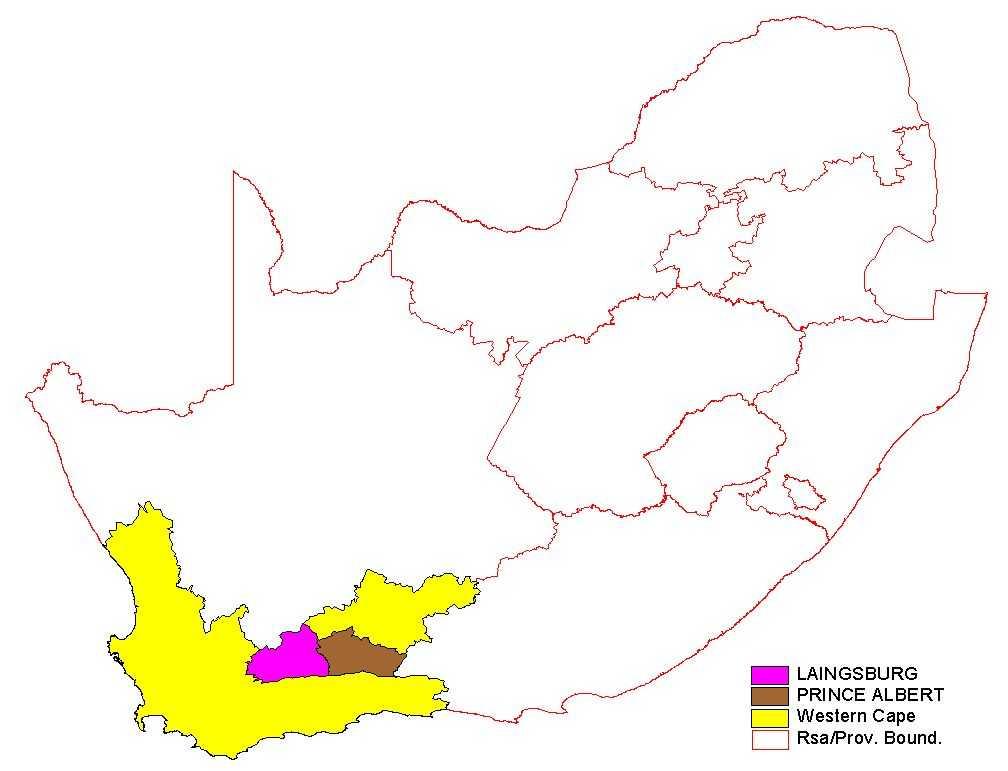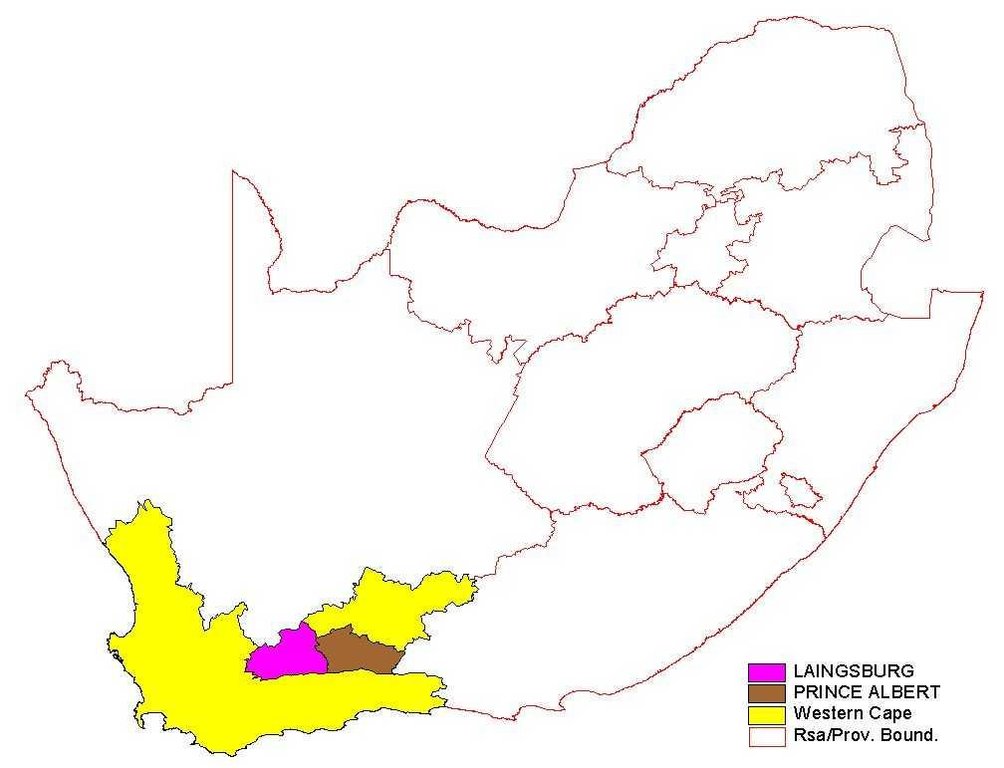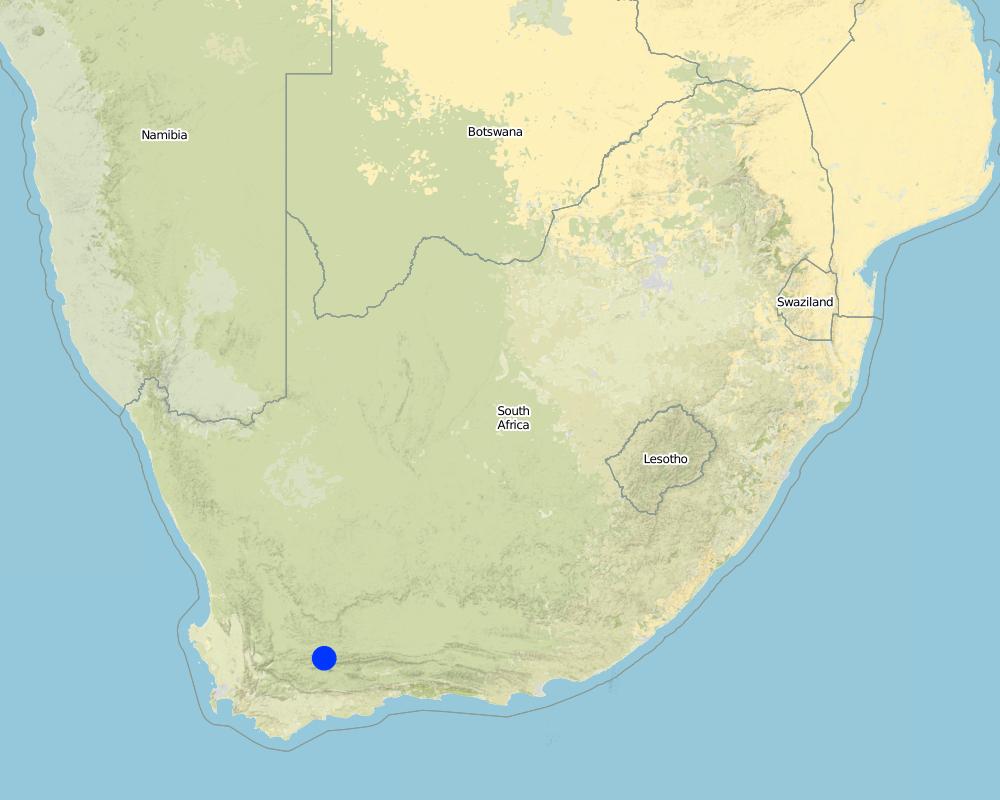Conservation Committees [South Africa]
- Creation:
- Update:
- Compiler: Philippe Zahner
- Editor: –
- Reviewer: Fabian Ottiger
approaches_2343 - South Africa
View sections
Expand all Collapse all1. General information
1.2 Contact details of resource persons and institutions involved in the assessment and documentation of the Approach
Name of the institution(s) which facilitated the documentation/ evaluation of the Approach (if relevant)
Swiss Agency for Development and Cooperation (DEZA / COSUDE / DDC / SDC) - Switzerland1.3 Conditions regarding the use of data documented through WOCAT
The compiler and key resource person(s) accept the conditions regarding the use of data documented through WOCAT:
Yes
2. Description of the SLM Approach
2.1 Short description of the Approach
The control of livestock numbers, plant management/control, and knowledge and control of plants and essential rest periods.
2.2 Detailed description of the Approach
Detailed description of the Approach:
Aims / objectives: Conservation committees. Successful commercial farmers. Research. Extension officer acts as an agent for transfer of research info
2.3 Photos of the Approach
2.5 Country/ region/ locations where the Approach has been applied
Country:
South Africa
Region/ State/ Province:
Western Cape
Map
×2.6 Dates of initiation and termination of the Approach
Indicate year of initiation:
1960
2.7 Type of Approach
- project/ programme based
2.8 Main aims/ objectives of the Approach
The Approach focused mainly on SLM with other activities (After mechanical constructions the recovery of the veld by biological processes is continued in order to get the optimal conservation condition)
Maximum use of available source for maximum profit while ecosystem is kept sound
2.9 Conditions enabling or hindering implementation of the Technology/ Technologies applied under the Approach
social/ cultural/ religious norms and values
- hindering
All grazing animals - those that produce well and those that are poor producers - eat equal amounts
Treatment through the SLM Approach: Efforts to persuade farmers to deliver the highest quality food possible with available grazing
availability/ access to financial resources and services
- hindering
Short term production reduction which curtails farmer's financial ability
Treatment through the SLM Approach: Subsidy/reduction of livestock numbers/aid scheme during severe droughts
knowledge about SLM, access to technical support
- hindering
Livestock less important than veld for grazing
Treatment through the SLM Approach: Information and advice
3. Participation and roles of stakeholders involved
3.1 Stakeholders involved in the Approach and their roles
- local land users/ local communities
Working land users were mainly men
Conservation Committee and extension officer visited farmers owing resource poor land and urged them to a commitment to conservation.
- SLM specialists/ agricultural advisers
- teachers/ school children/ students
- national government (planners, decision-makers)
Department of Agriculture
3.2 Involvement of local land users/ local communities in the different phases of the Approach
| Involvement of local land users/ local communities | Specify who was involved and describe activities | |
|---|---|---|
| initiation/ motivation | none | |
| planning | none | |
| implementation | none | |
| monitoring/ evaluation | none | |
| Research | none |
3.4 Decision-making on the selection of SLM Technology/ Technologies
Specify who decided on the selection of the Technology/ Technologies to be implemented:
- mainly land users, supported by SLM specialists
Explain:
land user driven (bottom-up).
Decisions on the method of implementing the SLM Technology were made by mainly by land users supported by SLM specialists. land user driven (bottom-up).
4. Technical support, capacity building, and knowledge management
4.1 Capacity building/ training
Was training provided to land users/ other stakeholders?
Yes
Specify who was trained:
- land users
- SWC specialists, extensionists/trainers, politicians/decision makers
Form of training:
- on-the-job
- farmer-to-farmer
- demonstration areas
- public meetings
- courses
Subjects covered:
Plant knowledge, veld management, balancing of stock numbers with veld capacity in accordance with technical norms
4.2 Advisory service
Do land users have access to an advisory service?
Yes
Specify whether advisory service is provided:
- on land users' fields
Describe/ comments:
Name of method used for advisory service: Agricultural Conservation Committees; Key elements: Livestock reduction, Prevention and reduction of erosion, Plant management; 1) Advisory service was carried out through: projects own extension structure and agents, government's existing extension system.
Advisory service is quite adequate to ensure the continuation of land conservation activities
4.3 Institution strengthening (organizational development)
Have institutions been established or strengthened through the Approach?
- yes, greatly
Specify the level(s) at which institutions have been strengthened or established:
- local
Specify type of support:
- financial
- capacity building/ training
4.4 Monitoring and evaluation
Is monitoring and evaluation part of the Approach?
Yes
Comments:
There were many changes in the Approach as a result of monitoring and evaluation: Timeous adaptations as process developed
4.5 Research
Was research part of the Approach?
Yes
Specify topics:
- sociology
- economics / marketing
- ecology
- technology
Give further details and indicate who did the research:
Research was carried out both on station and on-farm
5. Financing and external material support
5.1 Annual budget for the SLM component of the Approach
Comments (e.g. main sources of funding/ major donors):
Approach costs were met by the following donors: government (national): 60.0%; local community / land user(s) (-): 40.0%
5.2 Financial/ material support provided to land users
Did land users receive financial/ material support for implementing the Technology/ Technologies?
Yes
6. Impact analysis and concluding statements
6.1 Impacts of the Approach
Did the Approach help land users to implement and maintain SLM Technologies?
- No
- Yes, little
- Yes, moderately
- Yes, greatly
Reduction of livestock Establishment and conservation of seedlings in veld
Did other land users / projects adopt the Approach?
- No
- Yes, little
- Yes, moderately
- Yes, greatly
6.3 Sustainability of Approach activities
Can the land users sustain what has been implemented through the Approach (without external support)?
- no
If no or uncertain, specify and comment:
Somebody with initiative will supply the required stimulation to keep the approach alive and well and to help new farmers
6.4 Strengths/ advantages of the Approach
| Strengths/ advantages/ opportunities in the land user’s view |
|---|
| As consulted with extension officer |
| Strengths/ advantages/ opportunities in the compiler’s or other key resource person’s view |
|---|
| Adequate livestock composition (How to sustain/ enhance this strength: Adapt as circumstances change) |
| Knowledge of veld |
| Application of veld management with due consideration of seed production and the establishment of seedlings |
| Means to stabilise serious problems concerning erosion and to effect biological recovery |
6.5 Weaknesses/ disadvantages of the Approach and ways of overcoming them
| Weaknesses/ disadvantages/ risks in the land user’s view | How can they be overcome? |
|---|---|
| As consulted |
| Weaknesses/ disadvantages/ risks in the compiler’s or other key resource person’s view | How can they be overcome? |
|---|---|
| Lack of subsidy to establish infrastructure and combat severe droughts | |
| Decreased state funding of training institutions - effect on knowledge of average farmer | Sustained extension |
7. References and links
7.1 Methods/ sources of information
- field visits, field surveys
- interviews with land users
Links and modules
Expand all Collapse allLinks
No links
Modules
No modules





